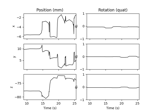mne.chpi.compute_chpi_locs#
- mne.chpi.compute_chpi_locs(info, chpi_amplitudes, t_step_max=1.0, too_close='raise', adjust_dig=False, *, verbose=None)[source]#
Compute locations of each cHPI coils over time.
- Parameters:
- info
mne.Info The
mne.Infoobject with information about the sensors and methods of measurement.- chpi_amplitudes
dict The time-varying cHPI coil amplitudes, with entries “times”, “proj”, and “slopes”. Typically obtained by
mne.chpi.compute_chpi_amplitudes().- t_step_max
float Maximum time step to use.
- too_close
str How to handle HPI positions too close to the sensors, can be
'raise'(default),'warning', or'info'.- adjust_digbool
If True, adjust the digitization locations used for fitting based on the positions localized at the start of the file.
- verbosebool |
str|int|None Control verbosity of the logging output. If
None, use the default verbosity level. See the logging documentation andmne.verbose()for details. Should only be passed as a keyword argument.
- info
- Returns:
- chpi_locs
dict The time-varying cHPI coils locations, with entries “times”, “rrs”, “moments”, and “gofs”.
- chpi_locs
See also
Notes
This function is designed to take the output of
mne.chpi.compute_chpi_amplitudes()and:Get HPI coil locations (as digitized in
info['dig']) in head coords.If the amplitudes are 98% correlated with last position (and Δt < t_step_max), skip fitting.
Fit magnetic dipoles using the amplitudes for each coil frequency.
The number of fitted points
n_poswill depend on the velocity of head movements as well ast_step_max(andt_step_minfrommne.chpi.compute_chpi_amplitudes()).New in v0.20.
